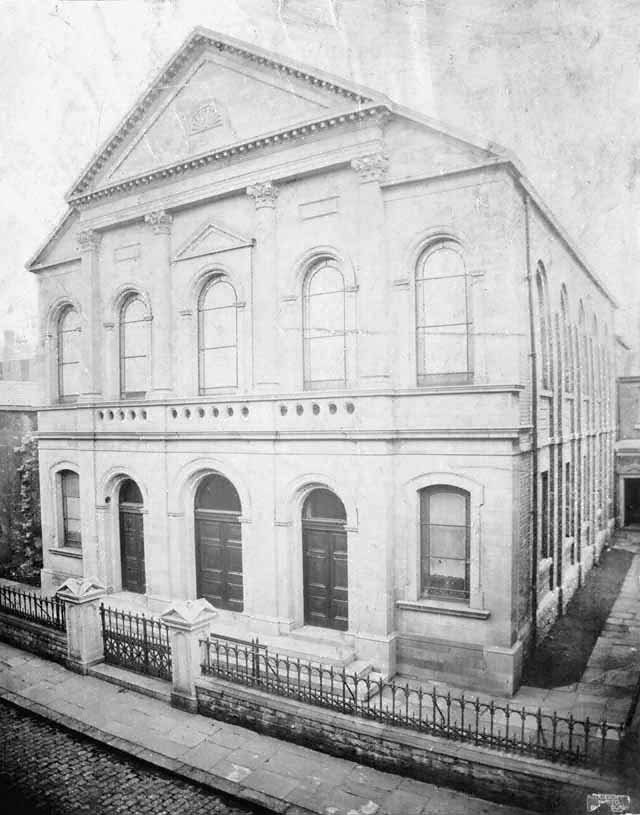 |
The Wesleyan Methodist Chapel of Clayton St, Blackburn |
 |
 | |
The following is extracted from "History of Blackburn" by Wm Alexander Abram, published in 1877
Wesleyan Methodism was introduced in Lower Darwen about the year 1758, but the earliest visit of John Wesley to Blackburn for the purpose Of preaching was in 1780. Wesley was again in Blackburn in 1781. His Journal records:-
"1781, Wednesday, June 23rd. Having appointed to preach at Blackburn, I was desired to take Kabb in my way (from Bolton). In the evening I preached in the new House at Blackburn.”
The "new house” referred to, opened by Wesley either on this or on the visit in 1780 was the original Methodist Chapel in the town, known as the Old Calendar House from its previous use, and purchased and adapted for a Chapel by the newly-formed Society of Methodists about the year 1780.
This building still exists, but has been many years used as shops and workshop. It stands on the N.E. side of Old Chapel Street. It is a brick structure, hardly to be distinguished from the other premises on either side. Its interior must have been small and incommodious. Wesley preached here on a third visit in 1784, as he narrates:-
"1784, April 17th. In the evening I preached at Blackburn, where the Society is lively and constantly increasing. Sunday, 18th. I preached at five [a.m.] to a numerous congregation, but not one well-dressed person among them, either morning or evening. Poor Blackburn!”
If the first Methodists in the town included few of the “quality” they soon grew in numbers until the Old Calendar House could not hold them, and, in the Spring of 1785, a project to erect a larger Chapel was afoot, of which the main promoters were Mr. William Banning and Mr. George Walkden. A site was got in Clayton-street, now near the midst of the town, but then an open suburb, surrounded by gardens and several respectable houses of tradesmen. The first Chapel in Clayton-street was opened in 1786. Wesley again came to preach, but the Chapel would not hold the large concourse of people. Wesley records in the journal:-
“1786, Monday, April 17th. I went on to Blackburn, which was sufficiently crowded, it being fair-day. No house would contain the peopIe, so I stood abroad and expounded that awful scripture, ‘I saw the dead smal1 and great stand before God.’ All was still as night, unless when they sung, - then their voices were as the sound of many waters.”
The trust deed of the Chapel of 1786 names as trustees :- Mr. William Sagar, Colne (Southfield, in Marsden) ; John Wood, Padiham ; Roger Crane, MichaeI Emmett, and William Bramwell, Preston ; John Crossley, Hoghton ; John Walmsley, Walton ; William Banning, John Haworth, Nicholas Aspinall, and George Walkden, Blackburn. Messrs. Banning and Walkden were the Blackburn leaders of Methodism in its infancy. Mr. Banning was a tradesman in Astley-gate, at whose house Wesley lodged on several of his visits. Mr. George Walkden, a “yeoman,” as described in the trust-deed, was a laborious local preacher in the district.
The Clayton-street Chapel in Blackburn was enlarged and almost rebuilt in 1816. Externally, the Chapel remains as it stood after this renovation. It is a square brick and stone fabric, with pointed windows, and two doorways, flanked by pillasters, on the north front. The interior measures about 65ft. by 55ft. Galleries are on the north, east, and west sides, and organ and choir are in a recess at the south end.
The Chapel has been twice or thrice restored internally since 1816 ; the last improvements were made in 1857-8 at the charge of the late Miss Newsham.
Sittings, 950.
| Blackburn Home & Contents | ©Lancashire OnLine Parish Clerks | Lancashire Home |